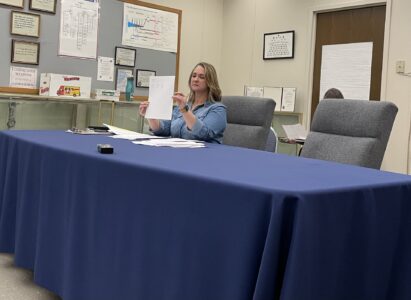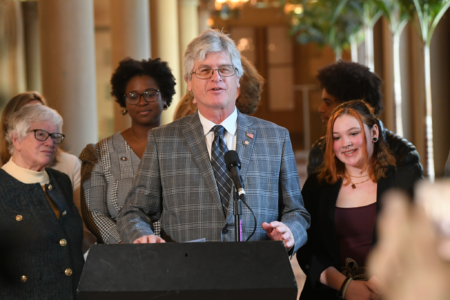Falconer’s Ellison Bronze Celebrates 100 Years
FALCONER – In this day and age, a 100-year-old company is hard to find. But just down the road on 125 W. Main St. in Falconer sits The Ellison Bronze Company Inc.
Ellison Bronze may or may not be known locally, but it is well-known throughout the world as a leading manufacturer of entry doors for large commercial buildings. In fact, Ellison is considered the worldwide standard for doors of this kind, crafted for landmark buildings and built to last a lifetime. Every Ellison door is manufactured and handcrafted in Falconer, and grace buildings like:
The World Trade Center Complex,
San Francisco’s Getty Museum,
The George Bush Presidential Library,
Smithsonian Museums,
federal courthouses,
universities, and
corporate headquarters.
For more than 80 years, Ellison has manufactured what are referred to as “balanced doors” for architects and designers throughout the world.
A “balanced door” is an entry door that doesn’t open on a hinge, but instead pivots at two-thirds the width of the door, creating a balance that distributes the weight so the door requires little force to open. The inset balancing point allows for an easier open force, even against external wind and internal building pressure, despite the added weight of the sturdy components. The design allows for even the largest and heaviest doors, made of the finest materials, to operate smoothly against harsh outdoor conditions. This is a perfect solution for high-profile buildings and skyscrapers.
The invention of the balanced door in 1928 put Ellison Bronze on the map.
A BRIEF HISTORY OF ELLISON BRONZE AND ITS “BALANCED DOOR”
Founded by the Robert Ellison family in 1914, Ellison Bronze started out as an ornamental metal company, which manufactured custom tablets, signs, elevator fronts, entrance doors, mausoleum equipment and special hardware. Then in 1928, on a very windy March day in Toledo, Ohio, two men watched from an office window as a woman struggled to open the door of a drug store against the wind.
One of the men, an architect, made a remark that was taken as a challenge by the other. He said, “The company that develops a door the wind helps open would be doing building owners and the public a great service.”
The other man, a sales manager for Ellison Bronze, shared the thought with brothers Edward and Oliver Ellison of Jamestown. The brothers used their collective engineering, designing and metallurgy skills to create an entry system that would answer this challenge. Eight months later, the sales manager returned to Toledo with the prototype of the first balanced door, now a staple of buildings around the world. Getting inside on a windy day soon became a whole lot easier. The balanced door was born.
The invention of the balanced door came during an era of increasing popularity for skyscrapers and tight-knit construction. This new building trend inspired a need for a higher-profile door that could resist both the external pressure of whipping winds through narrow streets and internal stack pressures. The architectural community embraced the concept, and the first Ellison-balanced door was manufactured and sold in 1932.
What the Ellison brothers did not know was that some of the balanced door systems they created in the first few years of production would still be in use after the turn of the millennium – more than 80 years later. It is also likely they did not foresee the advantages balanced doors would offer to the design and functional challenges of today’s architects and specifiers.
100 YEARS LATER
Today, the architectural community still holds the Ellison balanced door in high esteem, as they are used on the highest-profile buildings with the most ambitious designs throughout the world.
To architects, a building’s entrance is among its most valuable assets. And so it is critical that a door serves as a visual symbol of the building to which it facilitates access. To match the worthiness of a new building, it also must be strong, durable, attractive and sustainable. Ellison balanced doors are all of the above.
“It’s the door you can open with one finger.”
This Ellison ad slogan from the 1930s stands true to its sentiment today. More than 80 years later, many of the Ellison balanced doors from the era also stand true to their quality.
“We will never lose our pride in old-world craftsmanship,” said Roger Overend, vice president of operations for Ellison Bronze. “Every door that we manufacture achieves the very highest standards so that it can last for generations. In fact, we still know of some our doors that have been in continuous operation since the 1930s.”
With a commitment to old-world craftsmanship also comes the responsibility of meeting today’s increasingly stringent demands and new technologies. Ellison Bronze still works out of its original foundry, but has invested significantly in new machinery and improving its engineering practices to better communicate with and assist today’s architects and designers.
“With each passing year, the architectural industry is more demanding,” Overend said. “The Internet age has resulted in customers who expect service, information and the final product quickly without sacrificing quality. We’re proud of the fact that we are able to adapt and grow, and even get stronger, as time goes by.”
FALCONER
Through its founding, and times of difficulty, and many expansions, Ellison Bronze has relied on the support of Falconer.
“It’s an honor for a company to stay in one place for 100 years,” Overend said. “The relationship between Ellison Bronze and the village of Falconer is a testament to that honor. We appreciate all of the support, not to mention the great workforce that accommodates our needs here. We are extremely proud of our workers and everything they do for us.”
THE FUTURE
Ellison Bronze must constantly strike a delicate balance between the old and the new. Its rich history can’t be ignored, but neither can the latest trends and performance needs of today’s architecture and today’s cities. It’s old-world craftsmanship, but with 2014 deadlines. It’s not easy, but Ellison has been doing it with flair, from Falconer. This might be best summed up by a recent customer request:
“Some of our doors from the 1930s, which are still installed today, were just sent back to us so that we could put new hardware on them,” Overend said. “Now, they are like new. We are proud to be able to say that.”





